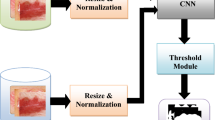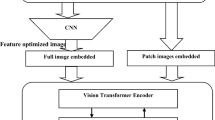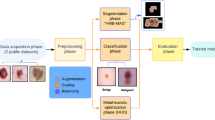Abstract
Psoriasis is a severe skin disease that is surveyed outwardly by dermatologists. In recent years, computer vision is the major solution for diagnosing the psoriasis skin disease by segmenting the infected skin images. Besides, many researchers had presented efficient machine learning techniques for segmenting the psoriasis skin images. Nevertheless, accuracy and time consumption of the model are further to be improved. Thus, in this work, we present adaptive chimp optimization algorithm (AChOA)–based convolutional neural network (CNN) which is introduced for automatic segmentation of psoriasis skin images. After pre-processing, the input images are segmented using AChOA-CNN model where weight and bias values of CNN are optimized with the AChOA. The search ability of ChOA is enhanced by adapting the chaotic sequence based on tent map. At final, from the segmented output images, artifacts are removed by applying the threshold module. From the simulation, we attain 97% of accuracy.














Similar content being viewed by others
Availability of Data and Material
Data sharing is not applicable to this article because of proprietary nature.
Code Availability
Code sharing is not applicable to this article because of proprietary nature.
References
Tancharoen, Datchakorn, Patinya Tantawiwat, and Piya Kovintavewat. “Medical Imaging using Automatic Region of Interest Segmentation for Psoriasis Diagnosis.” In 2019 34th International Technical Conference on Circuits/Systems, Computers and Communications (ITC-CSCC), pp. 1–4. IEEE, 2019.
Lu, Juan, Ed Kazmierczak, Jonathan H. Manton, and Rodney Sinclair. “Automatic segmentation of scaling in 2-D psoriasis skin images.” IEEE transactions on medical imaging 32, no. 4 (2012): 719–730.
George, Yasmeen, Mohammad Aldeen, and Rahil Garnavi. “Pixel-based skin segmentation in psoriasis images.” In 2016 38th Annual International Conference of the IEEE Engineering in Medicine and Biology Society (EMBC), pp. 1352–1356. IEEE, 2016.
Stevens, Gretchen, Maya Mascarenhas, and Colin Mathers. “Global health risks: progress and challenges.” (2009): 646–646.
Lu, Juan, Ed Kazmierczak, Jonathan H. Manton, and Rodney Sinclair. “A quantitative technique for assessing the change in severity over time in psoriatic lesions using computer aided image analysis.” In 2013 35th Annual International Conference of the IEEE Engineering in Medicine and Biology Society (EMBC), pp. 2380–2383. IEEE, 2013.
Hameed, Nazia, Antesar Shabut, and M. Alamgir Hossain. “A Computer-aided diagnosis system for classifying prominent skin lesions using machine learning.” In 2018 10th Computer Science and Electronic Engineering (CEEC), pp. 186–191. IEEE, 2018.
Chan, Stephanie, Vidhatha Reddy, Bridget Myers, Quinn Thibodeaux, Nicholas Brownstone, and Wilson Liao. “Machine learning in dermatology: current applications, opportunities, and limitations.” Dermatology and therapy 10, no. 3 (2020): 365–386.
Hogarty, Daniel T., John C. Su, Kevin Phan, Mohamed Attia, Mohammed Hossny, Saeid Nahavandi, Patricia Lenane, Fergal J. Moloney, and Anousha Yazdabadi. “Artificial intelligence in dermatology—where we are and the way to the future: a review.” American journal of clinical dermatology 21, no. 1 (2020): 41–47.
Li, Hongfeng, Yini Pan, Jie Zhao, and Li Zhang. “Skin disease diagnosis with deep learning: a review.” arXiv preprint arXiv:2011.05627 (2020).
George, Yasmeen, Mohammad Aldeen, and Rahil Garnavi. “A pixel-based skin segmentation in psoriasis images using committee of machine learning classifiers.” In 2017 International Conference on Digital Image Computing: Techniques and Applications (DICTA), pp. 1–8. IEEE, 2017.
M. Dash, N. Londhe, S. Ghosh, A. Semwal and R. Sonawane, “PsLSNet: Automated psoriasis skin lesion segmentation using modified U-Net-based fully convolutional network”, Biomedical Signal Processing and Control, vol. 52, pp. 226–237, 2019.
D. Raju, H. Shanmugasundaram and R. Sasikumar, “Fuzzy segmentation and black widow–based optimal SVM for skin disease classification”, Medical & Biological Engineering & Computing, vol. 59, no. 10, pp. 2019–2035, 2021.
R. Arora, B. Raman, K. Nayyar and R. Awasthi, “Automated skin lesion segmentation using attention-based deep convolutional neural network”, Biomedical Signal Processing and Control, vol. 65, p. 102358, 2021.
R. Raj, N. Londhe and R. Sonawane, “Automated psoriasis lesion segmentation from unconstrained environment using residual U-Net with transfer learning”, Computer Methods and Programs in Biomedicine, vol. 206, p. 106123, 2021.
M. Dash, N. Londhe, S. Ghosh, R. Raj and R. Sonawane, “A cascaded deep convolution neural network based CADx system for psoriasis lesion segmentation and severity assessment”, Applied Soft Computing, vol. 91, p. 106240, 2020.
T. Khatibi, N. Rezaei, L. Ataei Fashtami and M. Totonchi, “Proposing a novel unsupervised stack ensemble of deep and conventional image segmentation (SEDCIS) method for localizing vitiligo lesions in skin images”, Skin Research and Technology, vol. 27, no. 2, pp. 126–137, 2020.
Khishe, Mohammad, and Mohammad Reza Mosavi. “Chimp optimization algorithm.” Expert systems with applications 149 (2020): 113338.
George, Yasmeen M., Mohammad Aldeen, and Rahil Garnavi. “Automatic psoriasis lesion segmentation in two-dimensional skin images using multiscale superpixel clustering.” Journal of Medical Imaging 4, no. 4 (2017): 044004.
Funding
The authors declare that they have competing interests and funding.
Author information
Authors and Affiliations
Contributions
All authors read and approved the final manuscript.
Corresponding author
Ethics declarations
Conflict of Interest
The authors declare no competing interests.
Additional information
Publisher's Note
Springer Nature remains neutral with regard to jurisdictional claims in published maps and institutional affiliations.
Rights and permissions
Springer Nature or its licensor (e.g. a society or other partner) holds exclusive rights to this article under a publishing agreement with the author(s) or other rightsholder(s); author self-archiving of the accepted manuscript version of this article is solely governed by the terms of such publishing agreement and applicable law.
About this article
Cite this article
Mohan, S., Kasthuri, N. Automatic Segmentation of Psoriasis Skin Images Using Adaptive Chimp Optimization Algorithm–Based CNN. J Digit Imaging 36, 1123–1136 (2023). https://doi.org/10.1007/s10278-022-00765-x
Received:
Revised:
Accepted:
Published:
Issue Date:
DOI: https://doi.org/10.1007/s10278-022-00765-x




